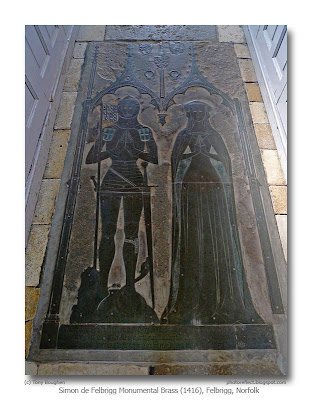
 click photo to enlarge
click photo to enlargeAnyone wanting to erect a lasting memorial to themselves could do worse than have one made in brass. Placed in an old building that will be looked after for centuries to come, such as a church, the worst that's likely to happen is the depredations of thieves as the price of metal inexorably rises on world markets, or steady corrosion by bat urine. Yes, bat urine (not to be confused with "Bat" Guano, the U.S. Army colonel played by Peter Sellers in the film, "Dr Strangelove"). Intrigued? Read on!
Today's photographs show two images of the brass memorial to Sir Simon de Felbrigg and his first wife, Margaret. It was commisioned by him in 1416, the year Margaret died, and his own dates are consequently left blank (he died in 1442 and is buried in Norwich). This brass is one of a number in Felbrigg church - two of the others are protected by the distant mats you can see in the nave, and we had to take a similar mat off this one to photograph it. Along with the other brasses in the church it was restored and relaid in 1987, but this large (5 feet 4 inches) and beautiful piece of work still shows signs of the damage it has received down the centuries. A couple of pieces, notably the top of the right "buttress", have broken off, probably due to routine wear or an accident. However, the drawn details in the brass and the edges of the shapes are almost as sharp as the day they were engraved and cut, and the text remains perfectly readable. If Sir Simon had chosen stone, marble, wood or any of the other commonly used materials it would have been considerably more worn. But, this brass has suffered both an indignity and damage that has been the fate of many such pieces in churches throughout the land. Bat urine, ejected by the nocturnal flying mammals as they circumnavigate the building during the hours of darkness searching for their prey, has caused spotting and slight etching of the surface due to the acidic nature of the liquid. In the UK all bat species are protected, and removing them from churches is not a course that church councils can easily pursue. Brasses fixed to walls are less prone to this kind of airborne damage, but those on floors can suffer badly. Consequently most are covered with a piece of natural felt on top of which is a rug. This combination minimises the scratching from any grit that gets on to the brass, as well as providing a protection from the bats' "emissions".
The first of my two photographs is a symmetrical, composed image, taken from a low viewpoint that shows the brass in the narrow nave flanked by eighteenth century box pews and lit by the distant west window seen through the tower arch. I took this shot for the lighting and mood. The second image is a record shot designed to illustrate more of the details of the brass itself.
Anyone interested in the problem of dealing with bats in ancient buildings can find out more information here.
photograph & text (c) T. Boughen
Photo 1 (Photo 2)
Camera: Lumix LX3
Mode: Aperture Priority
Focal Length: 5.1mm (24mm/35mm equiv.)
F No: f2.8 (2.0)
Shutter Speed: 1/125 (1/30)
ISO: 80 (125)
Exposure Compensation: -1.33 EV
Image Stabilisation: On